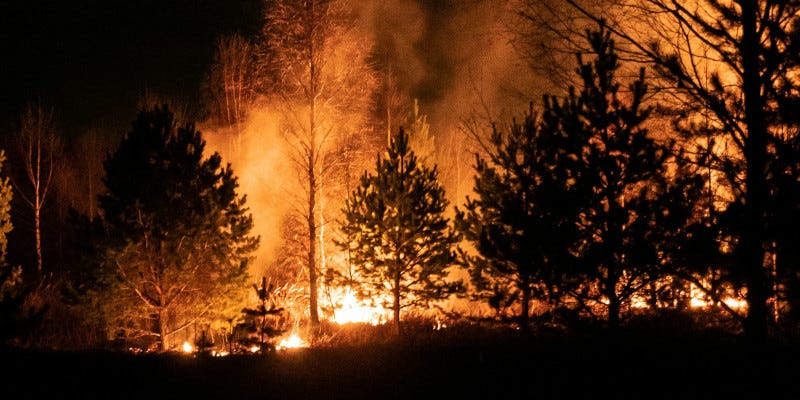UN University report warns against carbon credits from REDD, tree planting, and improved forest management
But the report stops short of recommending banning the trade in carbon temporarily stored in trees.

A new report published by the United Nations University Institute for Water, Environment and Health warns that carbon markets that fund REDD, tree planting, and improved forest management could worsen the climate crisis.
Forests have historically been seen as one of the most effective terrestrial carbon sinks. However, over the past 10 years, forests and peatlands have increasingly transitioned into massive carbon emitters in many parts of the world due to increasing wildfires. Carbon mitigation actions and climate policies including Voluntary Carbon Market (VCMs), REDD+ (Reducing Emissions from Deforestation and forest Degradation), ARR (Afforestation, Reforestation, and Revegetation), IFM (Improved Forest Management), and the Paris Agreement fail to account for these substantial emissions.
The United Nations University (UNU) is the academic arm of the UN, and the UNU Institute for Water, Environment and Health (UNU-INWEH) was set up in 1996 as the “UN’s Think Tank on Water”.
The report was written by Ju Hyoung Lee, Amir AghaKouchak, Mir Matin, Kaveh Madani all of UNU-INWEH, together with Johannes Kieft of the UN Environment Programme.
The report notes that REDD, tree planting, and improved forest management projects have been “primarily focused on encouraging the growth of VCM markets, which have had limited progress in actual carbon reduction”.
The reason for this is that “these policies do not reflect our changing environments and increasing wildfires”.
Of course, that’s actually not the only reason. The problems of leakage, additionality, permanence, and measurement have plagued REDD from the very beginning.
Forests: Super carbon emitters
UNU-INWEH’s report concludes that,
In many parts of the world, forests and peatlands, previously considered to be the largest terrestrial carbon storehouses, are transitioning into super carbon emitters under warming conditions, due to large and frequent wildfires.
When forests are affected by wildfires or droughts, forests can release massive amounts of carbon.
In 2024, 6.7 million hectares of tropical primary forest was lost globally. Almost half of the destruction was caused by fire. And the destruction was not limited to the tropics. Extreme fires took place in Canada and Russia, contributing to record global tree cover loss. In 2024, global tree cover loss hit 30 million hectares, an increase of 5% compared to 2023.
UNU-INWEH’s report states,
When affected by wildfires or droughts, forests fail to perform the functions that carbon markets expect from them and instead release massive amounts of carbon. This issue is often ignored in the VCMs-based carbon verification and trading frameworks.
In 2023, wildfires in Canada covered an area of 18.5 million hectares. This resulted in approximately 2 gigatonnes of fire-driven carbon dioxide emissions. That’s more than three times Canada’s average carbon emissions. This year, smoke from the fires in Canada has reached Europe.
“The boreal forests, once considered one of the largest terrestrial carbon sinks, are now evolving to super carbon emitters,” UNU-INWEH’s report notes.
However, such massive carbon emissions are often ignored or underestimated by VCMs, and carbon offset schemes. Accordingly, they fail to adequately account for the dual functionality of forests, mechanically assuming forests as carbon sinks. This issue has led to an overestimation of the role of forestation as a solution to climate change.
Policy recommendations
The most obvious policy recommendation from the ever increasing threat of wildfires would be to stop generating carbon credits from REDD, tree planting, and improved forest management projects.
Six years ago, Lauren Gifford of Colorado State University wrote a Guest Post on REDD-Monitor with the headline, “The Amazon fires mark the end of REDD+”. She wrote that,
As the Amazon rainforest burns, and reaches what some scientists have called a “tipping point,” beyond which it might never recover, it is time to unequivocally call an end to the experiment that is REDD+, the development mechanism designed to offset carbon dioxide pollution via investment in tropical forest conservation. The attempt to Reduce Emissions from Deforestation and Degradation has failed.
But we’re dealing here with a report from a UN agency. Instead of recommending a ban on carbon credits from trees, UNU-INWEH makes three recommendations:
Reform carbon offset schemes to address natural carbon emissions from forests;
Implement adaptive-anticipatory governance for forest fire management; and
Leverage satellite observations to advance Voluntary Carbon Markets.
The call to “reform carbon offset schemes” rather than scrapping them has been heard since the very first carbon offset projects were developed. But after several decades of failed carbon offset schemes — and a complete failure to reform them — surely the time has long since passed to acknowledge offsetting as a false solution.
The report does suggest excluding some forests from carbon markets:
Satellite observations can identify areas where forests are growing, and fuels are accumulating. Such forest environments should be excluded from carbon offset markets and forestation plans, due to potential high emissions in case of future fires.
Taking actions to address forest fires obviously makes sense. But doing so in order to trade the carbon temporarily stored in trees against continued burning of fossil fuels makes no sense. Burning fossil fuels is driving the climate crisis. And burning fossil fuels is making forests ever more vulnerable to fire.
Unfortunately, UNU-INWEH’s report makes no mention of fossil fuels.





We are now over 430 ppm of CO2. Where does this end? If all forests were "managed" by humans, there would be no old-growth forests and all the biodiversity that goes with that. If you stand there thinking the forest is in your way, no, you are. Tell me that date when all this ends. There must be a date.